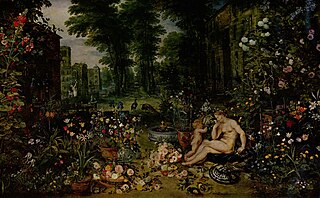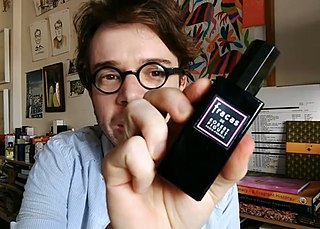Perfume is a mixture of fragrant essential oils or aroma compounds (fragrances), fixatives and solvents, usually in liquid form, used to give the human body, animals, food, objects, and living-spaces an agreeable scent. Perfumes can be defined as substances that emit and diffuse a pleasant and fragrant odor. They consist of manmade mixtures of aromatic chemicals and essential oils. The 1939 Nobel Laureate for Chemistry, Leopold Ružička stated in 1945 that "right from the earliest days of scientific chemistry up to the present time, perfumes have substantially contributed to the development of organic chemistry as regards methods, systematic classification, and theory."
Body odor or body odour (BO) is present in all animals and its intensity can be influenced by many factors. Body odor has a strong genetic basis, but can also be strongly influenced by various factors, such as sex, diet, health, and medication. The body odor of human males plays an important role in human sexual attraction, as a powerful indicator of MHC/HLA heterozygosity. Significant evidence suggests that women are attracted to men whose body odor is different from theirs, indicating that they have immune genes that are different from their own, which may produce healthier offspring.

An aroma compound, also known as an odorant, aroma, fragrance or flavoring, is a chemical compound that has a smell or odor. For an individual chemical or class of chemical compounds to impart a smell or fragrance, it must be sufficiently volatile for transmission via the air to the olfactory system in the upper part of the nose. As examples, various fragrant fruits have diverse aroma compounds, particularly strawberries which are commercially cultivated to have appealing aromas, and contain several hundred aroma compounds.

Air fresheners are products designed to reduce unwanted odors in indoor spaces, or to introduce pleasant fragrances, or both. They typically emit fragrance to mask odors, but may use other methods of action such as absorbing, bonding to, or chemically altering compounds in the air that produce smells, killing organisms that produce smells, or disrupting the sense of smell to reduce perception of unpleasant smells.
Balenciaga SA is a luxury fashion house founded in 1919 by the Spanish couturier Cristóbal Balenciaga in San Sebastián, Spain. Balenciaga produces ready-to-wear footwear, handbags, and accessories, and licenses its name and branding to Coty for fragrances. It is currently owned by the French corporation Kering.
Aromachology is the study of the influence of odors on human behavior and to examine the relationship between feelings and emotions. Those who practice aromachology are aromachologists. Aromachologists analyze emotions such as relaxation, exhilaration, sensuality, happiness and well-being brought about by odors stimulating the olfactory pathways in the brain and, in particular, the limbic system. Different wearers are thought to have unique physiological and psychological responses to scents, especially those not manufactured synthetically but based on real scents. The word "aromachology" is derived from "aroma" and "physio-psychology", the latter being the study of aroma. This term was coined in 1989 by what is now the Sense of Smell Institute (SSI), a division of The Fragrance Foundation. The SSI defines aromachology as "a concept based on systematic, scientific data collected under controlled conditions". The term is defined as the scientifically observable influence of smell on emotions and moods. Consumers use aromachology to alleviate time pressures, for relaxation or stimulation and as a component of other activities that generate a feeling of well-being.

An odor or odour is caused by one or more volatilized chemical compounds that are generally found in low concentrations that humans and many animals can perceive via their sense of smell. An odor is also called a "smell" or a "scent", which can refer to either an unpleasant or a pleasant odor.

The sense of smell, or olfaction, is the special sense through which smells are perceived. The sense of smell has many functions, including detecting desirable foods, hazards, and pheromones, and plays a role in taste.
Christophe Laudamiel is a French perfumer, chemist, writer and model. He is co-founder and Master Perfumer of DreamAir creative studios in New York City, where he currently resides. In 2019 he was named Chief Perfumer to BélAir Lab in Tokyo: a perfume composition and technology studio newly managed by Rohto Pharmaceuticals. He is a founder and president of the non-profit Academy of Perfumery and Aromatics.

Digital scent technology is the engineering discipline dealing with olfactory representation. It is a technology to sense, transmit and receive scent-enabled digital media. The sensing part of this technology works by using olfactometers and electronic noses.
Scentography is the technique of creating and storing odor by artificially recreating a smell using chemical and electronic means.
Jacques Cavallier-Belletrud is a French perfumer formerly with the Swiss fragrance and flavor company Firmenich, who currently works for Louis Vuitton of the LVMH Luxury Group.

The Art and Olfaction Awards are a non-profit award mechanism designed to celebrate excellence in international artisan, experimental and independent perfumery and olfactory art through a yearly blind-judged competition.
The Institute for Art and Olfaction is a non-profit organization devoted to advancing public, artistic and experimental engagement with scent. It was founded in 2012.

Olfactory art is an art form that uses scents as a medium. Olfactory art includes perfume as well as other applications of scent.
Sillage in perfume refers to the trail created by a perfume when it is worn on the skin. It comes from the word in French for "wake" and can best be described as how a fragrance diffuses behind the wearer as they move. A fragrance does not need to be a heavy one to have a large sillage.

Christina Maria Agapakis is a synthetic biologist, science writer. She is the Creative Director of the biotechnology company Ginkgo Bioworks.

Fracas is a 1948 perfume created by French perfumer Germaine Cellier for French fashion designer Robert Piguet. It is based on the scent of tuberose, a pungent small white flower. A landmark fragrance, it has spawned many imitators and as of 2021 has been in production for more than 70 years later.

Alexandra Daisy Ginsberg is a British and South African artist who lives and works in London, UK. She is known for artworks that explore the relationship between humans, technology and nature. Many of her works are achieved using artificial intelligence and synthetic biology.

Olfactic communication is a channel of nonverbal communication referring to the various ways people and animals communicate and engage in social interaction through their sense of smell. Our human olfactory sense is one of the most phylogenetically primitive and emotionally intimate of the five senses; the sensation of smell is thought to be the most matured and developed human sense.











